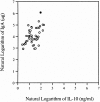Route and type of nutrition influence IgA-mediating intestinal cytokines
- PMID: 10235524
- PMCID: PMC1420810
- DOI: 10.1097/00000658-199905000-00008
Route and type of nutrition influence IgA-mediating intestinal cytokines
Abstract
Objective: To examine the levels of a Th1 IgA-inhibiting cytokine (interferon gamma) and the Th2 IgA-stimulating cytokines (interleukin [IL]-4, IL-5, IL-6, and IL-10) within the intestine of animals manipulated with enteral or parenteral nutrition, and to correlate these cytokine alterations with intestinal IgA levels.
Summary background data: Enteral feeding significantly reduces the incidence of pneumonia in critically injured patients compared with intravenous total parenteral nutrition (IV TPN) or no nutritional support. Experimentally, complex diets prevent impairments in mucosal immunity induced by IV TPN. These impairments include decreases in intestinal and respiratory tract IgA levels, impaired IgA-mediated antiviral defenses, and increases in the mortality rate against established immunity to Pseudomonas pneumonia. Intragastric (IG) TPN maintains antiviral defenses but only partially preserves protection against Pseudomonas pneumonia. Because IgA levels depend on interactions between Th1 IgA-inhibiting and Th2 IgA-stimulating cytokines, the authors postulated differences in gut cytokine balance in enterally and parenterally fed mice.
Methods: Sixty-one mice were randomized to receive chow, IV TPN, IG TPN, or an isocaloric, complex enteral diet. After 5 days of feeding, animals were killed and supernatants from samples of intestine were harvested, homogenized, and assayed for Th1 and Th2 cytokines by enzyme-linked immunosorbent assay.
Results: The Th2 cytokines, IL-5 and IL-6, and the Th1 cytokine, interferon gamma, remained unchanged by diet. IL-4 levels decreased significantly in both IV and IG TPN groups versus the chow or complex enteral diet groups, whereas IL-10 decreased only in IV TPN mice. Decreases in Th2 cytokines correlated with intestinal IgA levels.
Conclusion: Chow and complex enteral diets maintain a normal balance between IgA-stimulating and IgA-inhibiting cytokines while preserving normal antibacterial and antiviral immunity. The IgA-stimulating cytokine IL-4 drops significantly in mice receiving IG and IV TPN in association with reduced IgA levels, whereas IL-10 decreases significantly only in mice receiving IV TPN. These data are consistent with severely impaired mucosal immunity with IV TPN and partial impairment with IG TPN and provide a cytokine-mediated explanation for reduction in diet-induced mucosal immunity.
Figures



Similar articles
-
TPN decreases IL-4 and IL-10 mRNA expression in lipopolysaccharide stimulated intestinal lamina propria cells but glutamine supplementation preserves the expression.Shock. 2001 Apr;15(4):318-22. doi: 10.1097/00024382-200115040-00012. Shock. 2001. PMID: 11303733
-
Glutamine-enriched total parenteral nutrition maintains intestinal interleukin-4 and mucosal immunoglobulin A levels.JPEN J Parenter Enteral Nutr. 2000 Sep-Oct;24(5):270-4; discussion 274-5. doi: 10.1177/0148607100024005270. JPEN J Parenter Enteral Nutr. 2000. PMID: 11011781
-
Bombesin recovers gut-associated lymphoid tissue and preserves immunity to bacterial pneumonia in mice receiving total parenteral nutrition.Ann Surg. 2000 Jan;231(1):1-8. doi: 10.1097/00000658-200001000-00001. Ann Surg. 2000. PMID: 10636095 Free PMC article.
-
Impact of the feeding route on gut mucosal immunity.Curr Opin Clin Nutr Metab Care. 2014 Mar;17(2):164-70. doi: 10.1097/MCO.0000000000000033. Curr Opin Clin Nutr Metab Care. 2014. PMID: 24500441 Review.
-
The role of Th1 and Th2 cells for mucosal IgA responses.Ann N Y Acad Sci. 1996 Feb 13;778:64-71. doi: 10.1111/j.1749-6632.1996.tb21115.x. Ann N Y Acad Sci. 1996. PMID: 8611017 Review.
Cited by
-
Salmonella Typhimurium Adhesin OmpV Activates Host Immunity To Confer Protection against Systemic and Gastrointestinal Infection in Mice.Infect Immun. 2021 Jul 15;89(8):e0012121. doi: 10.1128/IAI.00121-21. Epub 2021 Jul 15. Infect Immun. 2021. PMID: 34097470 Free PMC article.
-
Impairment of mucosal immunity by parenteral nutrition: depressed nasotracheal influenza-specific secretory IgA levels and transport in parenterally fed mice.Ann Surg. 2001 Jan;233(1):134-8. doi: 10.1097/00000658-200101000-00019. Ann Surg. 2001. PMID: 11141235 Free PMC article.
-
Gastric emptying in mechanically ventilated critically ill patients: effect of neuromuscular blocking agent.Intensive Care Med. 2003 Oct;29(10):1717-22. doi: 10.1007/s00134-003-1898-5. Epub 2003 Jul 30. Intensive Care Med. 2003. PMID: 12897996 Clinical Trial.
-
Route of nutrition influences generation of antibody-forming cells and initial defense to an active viral infection in the upper respiratory tract.Ann Surg. 2003 Apr;237(4):565-73. doi: 10.1097/01.SLA.0000059991.89316.B8. Ann Surg. 2003. PMID: 12677154 Free PMC article.
-
Parenteral nutrition impairs gut-associated lymphoid tissue and mucosal immunity by reducing lymphotoxin Beta receptor expression.Ann Surg. 2006 Sep;244(3):392-9. doi: 10.1097/01.sla.0000234797.42935.46. Ann Surg. 2006. PMID: 16926565 Free PMC article.
References
-
- Moore FA, Moore EE, Jones TN, et al. TEN versus TPN following major abdominal trauma—reduced septic morbidity. J Trauma 1989; 29: 916–922. - PubMed
-
- Moore EE, Jones TN. Benefits of immediate jejunostomy feeding after major abdominal trauma—a prospective, randomized study. J Trauma 1986; 26: 874–880. - PubMed
-
- Buckman AL, Moukarzel AA, Bhuta S, et al. Parenteral nutrition is associated with intestinal morphologic and functional changes in humans. J Parenter Enteral Nutr 1995; 19: 453–460. - PubMed
Publication types
MeSH terms
Substances
Grants and funding
LinkOut - more resources
Full Text Sources
Research Materials
Miscellaneous

